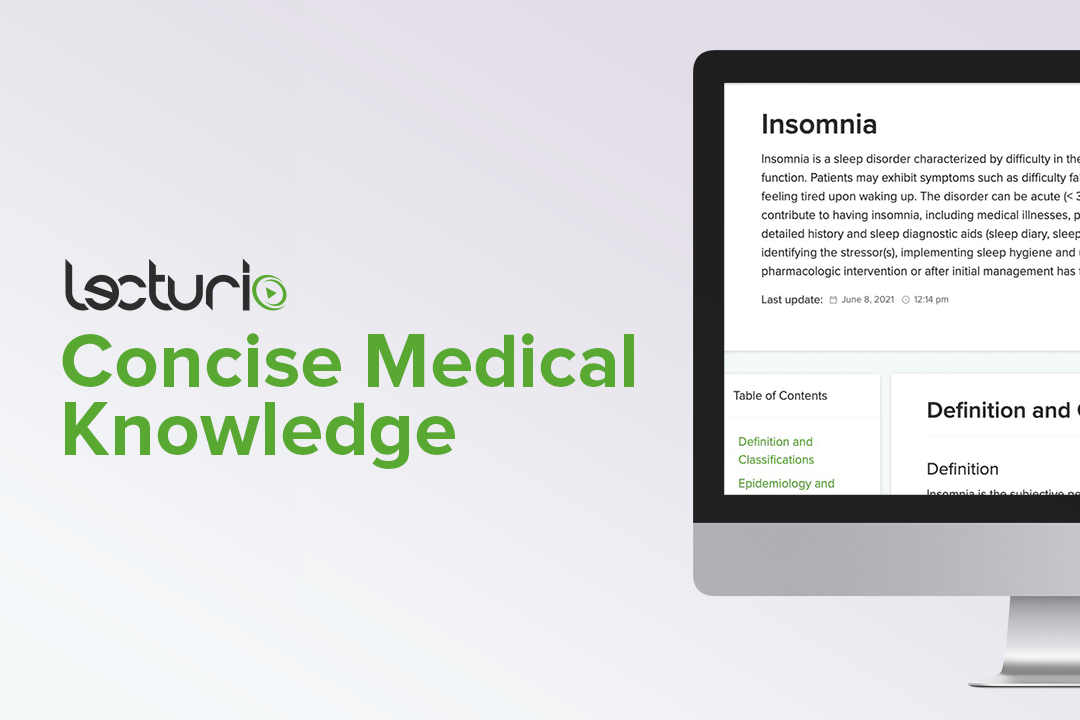Playlist
Show Playlist
Hide Playlist
Insomnia: Management
-
Slides Sleep Disorders Insomnia.pdf
-
Download Lecture Overview
00:00 Let's talk about the approach to managing patients with insomnia. 00:05 And here, I want you to think about the 3 P model. There are 3 Ps that we evaluate when managing patients with insomnia. The first is we want to think about and look for predisposing conditions. Things like anxiety that may predispose the patient to developing insomnia. The second is we want to look for precipitating factors, a recent illness, bereavement, death, a physical or mental stressor that may have precipitated this episode of insomnia. And then the last are perpetuating factors, things that keep the insomnia going. And we think about patient's sleep hygiene, sleep-wake cycle schedules, daytime behaviors. When we manage patients, we want to intervene, treat predisposing conditions, avoid and resolve precipitating factors, treat and improve perpetuating events, and the combination of all 3 of these management strategies is most successful when treating patients with insomnia. Let's talk about some of the non-pharmacologic management for short-term acute insomnia. First, we want to identify the stressor and address it accordingly and this is the most beneficial way to manage acute insomnia. We can use medications particularly if the insomnia is interfering with daytime function, but we want this to be temporary. Treating any underlying comorbidity, pain, depression, and other comorbidities before intensive sleep treatment can be important for these patients. what about non-pharmacologic management of chronic insomnia? Here, we have a number of goals. We want to improve sleep hygiene by avoiding alcohol, caffeinated drinks, or large meals within 4 hours of bedtime. Regular exercise patterns are important but we want to avoid vigorous exercise too close to bedtime within 3 hours of going to sleep. We want to avoid napping during the day or daytime sleeping, we counsel patients to use the bed only for sleep and other related activities. No eating, telephone, or other stimulation within bed. And reduce light exposure around bedtime. Cognitive behavioral therapy is an important intervention for patients with chronic insomnia. 02:23 It's a first line treatment. We have a number of goals including the increased sleep efficiency, address maladaptive thoughts, and promote a stable routine of sleep and wake times. We can conduct this in a number of ways, we can set a time for sleep each day, and encourage the patient to follow a sleep schedule and that regular schedule helps to change melatonin secretion and the circadian rhythm to promote sleep. Sleep restriction or reducing the amount of time that the patient is in bed, delaying this further and further to limit time in bed without sleeping can be a helpful strategy. Stimulus control. Patient is anxious and cannot sleep, getting out of bed, doing another activity, and then returning to bed to sleep can be helpful. 03:10 And then we think about interventions to improve sleep hygiene. What about pharmacotherapy? What medications are available to treat sleep? We typically think about these for a temporary course. The first category are the hypnotic benzodiazepines. These act on gaba receptors and you can see some examples. 03:29 Temazepam, clonazepam, being 2 common examples. There are the non- benzodiazepine agents. These are benzodiazepine agonists and they also act on gaba receptors and some examples include zolpidem. Melatonin agonist can be used. 03:47 Melatonin is the natural hormone that promotes sleep. We ask patients to take naturally occurring melatonin about an hour before bed to promote that boost of melatonin that encourages the brain to sleep and can reset the circadian rhythm and sleep-wake cycle. Dual orexin receptor antagonist can also be used. Orexin or hypocretin is important in the control of sleep and wake cycles and you can see several agents that act on these receptors. Histamine receptor antagonist can be used. The H1 receptor antagonist produces sedation and can help promote sleep. 04:28 There is the potential for tolerance and withdrawal from this agent and these are not commonly used except in very short circumstances temporarily. And antidepressants with sedating properties also can improve the ability to get to sleep and can be helpful in treating both comorbid conditions as well as insomnia in off-label use.
About the Lecture
The lecture Insomnia: Management by Roy Strowd, MD is from the course Sleep Disorders.
Included Quiz Questions
What is the most appropriate strategy for managing short-term or acute insomnia?
- Identifying stressors and addressing them accordingly
- Prescribing benzodiazepines
- Referring for cognitive behavioral therapy
- Deep brain stimulation
- Exposure therapy
What is the most appropriate recommendation regarding sleep hygiene in a patient with chronic insomnia?
- Avoiding alcohol, caffeinated drinks, and large meals at least four hours before bedtime
- Exercising within one hour of sleeping to induce fatigue
- Using the bed for reading and watching television to subconsciously create a feeling of relaxation in bed
- Blue light therapy prior to sleeping
- Regular short “power naps” to reset the sleep–wake cycle
What two classes of medications are commonly used to treat insomnia?
- Antidepressants with sedative properties and melatonin agonists
- Partial opioid receptor agonists and nonsteroidal anti-inflammatory drugs
- Orexin agonists and selective serotonin reuptake inhibitors
- H2-receptor antagonists and melatonin agonists
- Benzodiazepines and barbiturates
What is the major risk of prescribing benzodiazepine receptor antagonists to treat insomnia?
- Addiction potential
- Paradoxical agitation
- Risk of neuroleptic malignant syndrome
- Vivid dreams
- Increased risk of night terrors
Customer reviews
5,0 of 5 stars
| 5 Stars |
|
5 |
| 4 Stars |
|
0 |
| 3 Stars |
|
0 |
| 2 Stars |
|
0 |
| 1 Star |
|
0 |




